Is the Beef Brisket Point or Flat Better
If you are on a journey to discover who wins in a brisket flat vs. Point debate, you're in the right place.
We are going to show you the two cuts side by side and tell you what they are, the differences between them, and what they are suitable for…and not suitable for!
We'll also give you some pointers on preparation and cooking.
By the end of this article, you will be a bona fide Brisket boffin. Let's get into it.
Contents (Jump to Topic)
- 1 What is Brisket?
- 2 Brisket Flat Overview
- 2.1 Where on the cow it Comes from?
- 2.2 How Much Meat and Fat Does it Contain?
- 2.3 Nutritional Information
- 2.4 Portion Size: How Much of this Cut Per Person?
- 2.5 How to Prepare the Cut for Grilling or Smoking
- 2.6 How to Cook the Cut
- 3 Where to Buy Brisket Flat Online
- 4 Brisket Point
- 4.1 Where on the cow it Comes from?
- 4.2 How Much Meat and Fat Does it Contain?
- 4.3 Nutritional Information
- 4.4 Portion Size: How Much of this Cut Per Person?
- 4.5 How to Prepare the Cut for Grilling or Smoking
- 4.6 How to Cook the Cut
- 5 Where to Buy Brisket Point Online
- 6 The Brisket Flat Vs. the Brisket Point
- 6.1 Cooking Methods — is One Easier to Cook Than the Other?
- 6.2 Is One Better for Grilling Than the Other?
- 6.3 Difference in Tenderness
- 6.4 Which is More Flavorful
- 6.5 Which is Usually Bigger?
- 6.6 Which is Better? The Brisket Flat or the Brisket Point
- 6.7 When Would You Pick One Over the Other?
- 7 Two Best Recipes for Brisket Flat Around the Web
- 7.1 BBQ Bible's Bacon-Smoked brisket flat
- 7.2 Hey Grill Hey's, No-Fail Smoked Texas Brisket
- 8 Two Best Recipes for Brisket Point Around the Web
- 8.1 Grillocracy's Better-than-Sex Brisket
- 8.2 At BBQs Kansas City Burnt Ends
- 9 Final Thoughts
What is Brisket?
We have an entire article answering 'what is brisket'. But in summary, brisket is a pair of muscles, that if you're looking at a cow side on, comes from the area of the chest, just above the front leg, or front a front view between the two front legs. The chest muscle, or pectorals.
It is a muscle that supports the cow's entire weight with every step, so it does a ton of work and hence is very dense and tough, with a lot of connective tissue.
As mentioned, the brisket is actually two separate but tightly connected muscles with very different makeup and feel. We have come to know the two pieces by the names 'brisket flat and brisket point.'
They cook and eat quite differently. And that's what we're going to discuss in the rest of this article.
For those who like a more visual telling, rather than a read, here is an excellent brisket overview from Jess Pryles:
Brisket Flat Overview
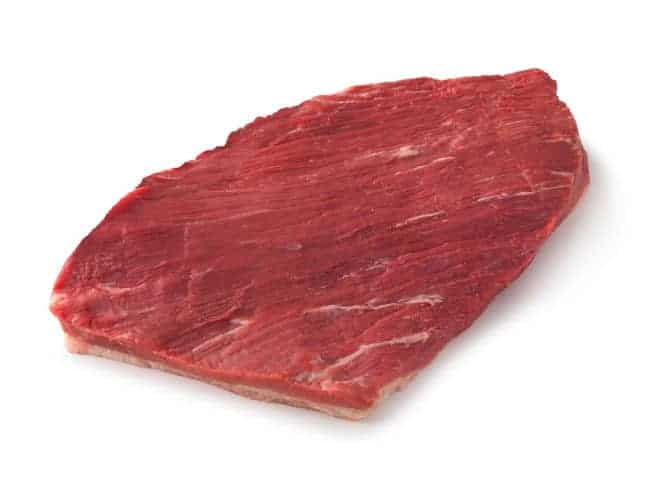
The flat is the flatter, meatier and leaner part of a whole brisket. It is 1-2 inches thick and can weigh anywhere between 5-10lbs. It has little in the way of interconnective tissue and can be tough if not cooked correctly.
The flat is also known as the brisket flat half, as it is half of a whole Brisket.
Sometimes referred to as the Beef Brisket Middle Cut; Brisket Center-Cut; Brisket First Cut; or Brisket Nose Cut. All of which relate to the position of the flat on the brisket itself.
The brisket is a huge roasting joint cut of Jewish origin.
Cured and smoked, it was sold in delis as precooked sliced meat in various forms. Most famous is the brisket, cured, pepper-crusted, and cooked slowly before being sliced and sold as pastrami, a well-known Jewish deli staple.
Due to its flat uniform shape, the brisket flat is excellent for slicing. The brisket flat looks as it sounds, a flat brisket.
Where on the cow it Comes from?
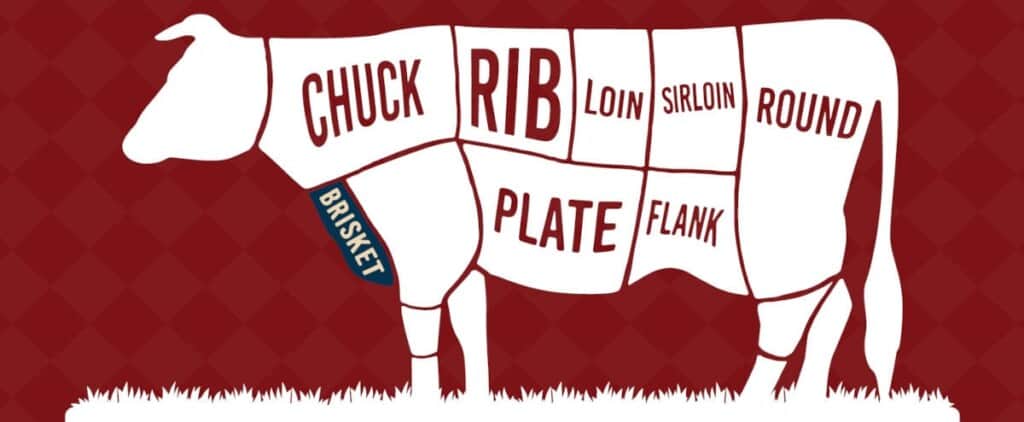
The brisket as a whole comes from the brisket primal. It is the front end of the cow around the chest area, between the front legs. The flat is known as the pectoralis major.
This muscle is one of the main movement muscles. It helps to extend the front legs forward and to lift the leg. As such, it is well worked, lean, and naturally tough.
The flat uniform look of the brisket flat allows you to differentiate it from the brisket point. It can be presented either as a relatively uniform cuboid or as an uneven and long flat piece of meat.
How Much Meat and Fat Does it Contain?
The brisket flat as a cut is the leanest part of the brisket. It will have a small amount of fat on the outside and minimal, but visible, marbling running throughout the joint.
With a total fat percentage of 17%, it produces a lot of meat with great flavor, with little fat ribbons and gristle.
Nutritional Information
| Nutrition | Total Amount | % Daily Value (based on 2000 calories/day) |
|---|---|---|
| Calories | 170 | 9% |
| Saturated Fat | 2.2 g | 13% |
| Sodium | 45 mg | 1.8% |
| Protein | 28 g | 56% |
| Iron | 2.4 mg | 15% |
| Zinc | 6.7 mg | 60% |
Portion Size: How Much of this Cut Per Person?
Whether you serve the brisket flat shredded or sliced, around a half lb. per person will be enough for a main meal unless they are a big eater. Fit and hungry teens and athletes should get up to 1lb. per person.
If shredding and putting the meat into a sandwich, then 4oz. Will be enough for most, and around 6-8oz. Will do for the hungrier among you.
How to Prepare the Cut for Grilling or Smoking
The brisket flat already comes with minimal fat on the outside, which you can reduce to nothing if you so wish. Just remember that the fat helps to baste the meat and keep it moist. So, some should be left on for the best results.
If there is any silver skin left, be sure to slice and pull it off. This stops it from holding the fiber of the meat together and making it seem chewy even if the meat underneath is moist and tender.
You then have a choice as to how you flavor your brisket flat. Generally, you will brine it if looking to make pastrami. Or you can make a rich marinade to add an assortment of flavors and a nice crust. Or, the preferred choice is to apply a dry rub for brisket, creating a beautiful bark during low and slow smoking that will taste divine.
How to Cook the Cut
There is no getting around the fact that the brisket flat is a low-n-slow only cut of meat. Hot-n-fast will leave you with a tough inedible slab.
The simplest way to cook the brisket flat is at low temperatures of 225-275f. Or for as long as it takes for the brisket to reach an internal temp of approx. 203F.
The choice of cooking temperature will dictate the length of cook versus the moisture in the meat. 275f will reduce cooking time and some moisture, whereas 225f will take a lot longer and mean moister meat as a result.
Once you understand the lengthy cooking process, you could then look at how some prefer to remove the brisket from the grill at around 150-170f internal. They then wrap the brisket in either foil or pink butcher's paper and place back on the grill. This is to avoid the stall where the brisket temperature plateaus.' It doesn't rise anymore as it sweats moisture, which has a cooling effect.
Where to Buy Brisket Flat Online
Not as widely available as brisket point, not so many online stores seem to stock it, though there are a few sources, and Crowd Cow have 3 types to choose from:
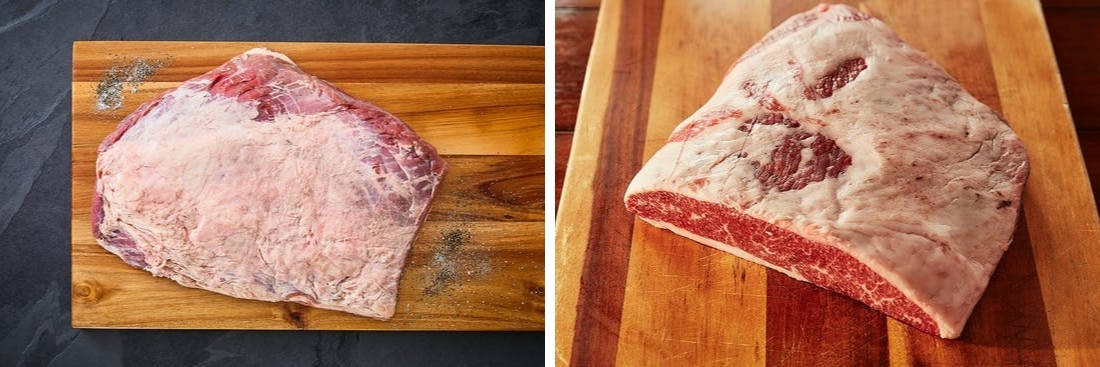
Crowd Cows pasture-raised brisket flat comes from Missouri Prime's network of family farms, where cattle are humanely raised on a 100% vegetarian diet, with access to both grass and grain during their finishing period. It has superior marbling and a rich buttery taste. Each cut weighs approximately 3 lbs.
Crowd Cow's 100% grass-fed brisket flat is sourced from Broadleaf Farms of New Zealand and is their AngusPure Special Reserve line of 100% grass-fed beef, which gives a rich taste with superb texture. Each cut weighs approximately 3 lbs.
Finally, Crowd Cow sells a Japanese A5 Wagyu brisket flat from Kagoshima wagyu. These flats are pre-trimmed — so there will be nothing you need to cut and throw away as waste — and sold at 3 lb in weight. The insane marbling and rich umami taste of this beef makes it some of the most sought after beef in the world.
Check Price on Crowd Cow
Alternatives:
Other places to buy brisket flat online include:
- D'artagnan
- Wild Fork Foods
Brisket Point
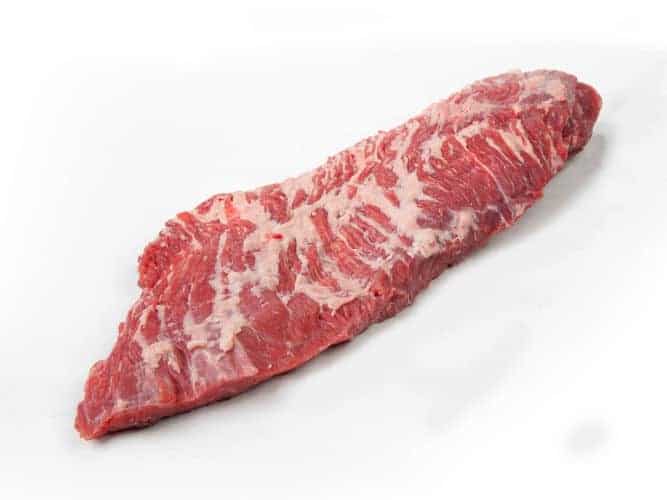
The brisket point is the other half of the whole brisket. It is thicker but smaller in overall dimensions. It has more marbling, fat, and connective tissue than the brisket flat cut. This means significantly more flavor from the extra fat but less meat yield.
The name brisket point goes some way to giving you an idea of what this cut looks like. It is thicker and looks more like a traditional meat joint that is thick and tapered at one end, hence the 'Point.'
Due to its higher fat content, the brisket point is often shredded rather than sliced, making for an easier chew and texture. Slicing isn't out of the question, though. The point will give a nice chunk of meat when sliced and served if you are a fan of fattier cuts.
The other most commonly used name for the point is the 'Deckle'. This is the name given to the long thick, fat and muscular layer that attaches the flat to the rib cage. In other words, the point itself.
Where on the cow it Comes from?

The brisket point also comes from the brisket primal as it is attached to the brisket flat. The difference is that it is the pectoralis minor muscle. The two muscles are joined in the chest and work together for the movement of the front legs.
The tapered shape of the brisket point means it is easy to differentiate from the brisket flat. It comes with a thick layer of fat all over and has thick layers of intramuscular fat that are clearly visible.
How Much Meat and Fat Does it Contain?
The brisket point is made up of 21% fat and 18% protein. Although fairly fatty, when shredded, the yield of meat is still plentiful.
Nutritional Information
| Nutrition | Total Amount | % Daily Value (based on 2000 calories/day) |
|---|---|---|
| Calories | 200 | 10% |
| Saturated Fat | 4.4 g | 23% |
| Sodium | 65 mg | 2.5% |
| Protein | 24 g | 48% |
| Iron | 2.3 mg | 15% |
| Zinc | 6.2 mg | 60% |
Portion Size: How Much of this Cut Per Person?
As mentioned before, the rule of thumb with meat is usually advised as a half lb. person on average. You then increase for big eaters, athletic folk, and hungry teenagers.
Due to the higher fat content and slightly greasier texture, some may naturally eat less of this cut. Or some may reduce their portion as it is more calorific.
How to Prepare the Cut for Grilling or Smoking
The brisket point is often used for shredding or making brisket burnt ends, so no trimming of the fat is required. It is the fat that gives the flavor to this piece when cooked well.
Most fans of the point will recommend a good dry rub of some sort. It can be as simple as a salt and pepper rub, or an excellent triple-C rub (coffee, cocoa, and chili). A dry rub will allow for a great bark. Just be sure to choose a rub that compliments the beefy flavor that will not overpower it.
How to Cook the Cut
Like the brisket flat, the point must be cooked low-n-slow, but there are many ways to approach it.
You can cook it low and straight through to done, or you can pull it at 150-165f and wrap it. Or you can even double smoke like you would to produce burnt ends.
Whatever you choose to do, the point will always be ready at around the 200f mark. The tell-tale sign will be a wobble on the meet like a jello pudding.
Where to Buy Brisket Point Online
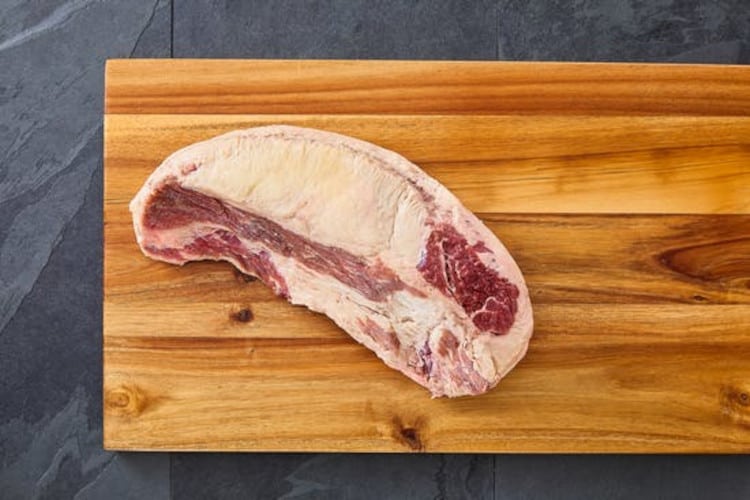
Crowd Cow's brisket point is 100% grass-fed, sourced from Broadleaf Farms in New Zealand, and comes in at 5 lb in weight.
Grass-fed beef is naturally leaner but has a deeper, beefier taste while being higher in heart-healthy Omega 3's.
Check Price on Crowd Cow
Alternatives:
Other trusted and quality online suppliers you could source brisket point from include:
- Farm Field Table
- Boxed Halal
The Brisket Flat Vs. the Brisket Point
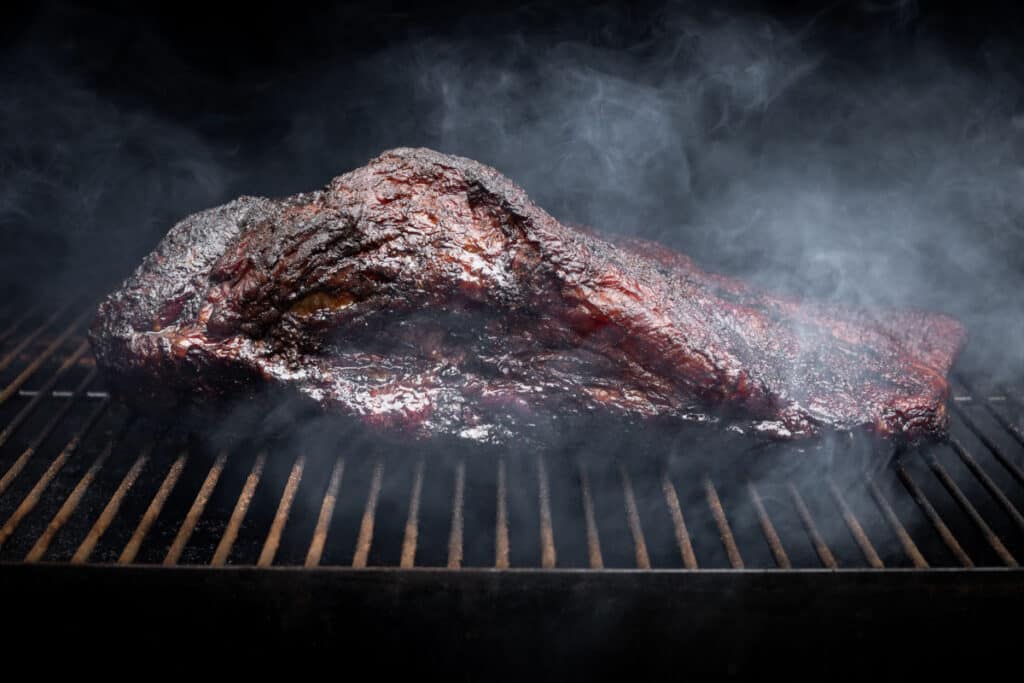
As already detailed, the Flat and the Point together make up the brisket as a whole.
When bought in this guise, it is known as a 'packer cut brisket.' So, coming from the same primal and muscle group, the two cuts are very similar in flavor. They both have a big beefy flavor due to the marbling.
The flat is leaner and less buttery in its texture. The point is melt-in-the-mouth good and fantastically silky on the mouth when shredded.
Both can be rested and stored for 3 to 5 days after cooking. Served cold or reheated via sous vide, steaming, or a light smoke to bring it up to a safe temperature.
Cooking Methods — is One Easier to Cook Than the Other?
For the whole brisket, the flat, or the point, the approach to cooking is pretty much the same.
Choose a method you like the sound of, that you are confident you can commit to, and follow it to the letter. A good tip here is to learn from other people's mistakes so that you don't have to make the same ones.
Low-n-slow is the way to go, with or without regular spritzing or addition of BBQ mop sauce, so be sure to understand that there is no quick way to good brisket. It can be anything from 5-16 hours, depending on the size of the cut and the technique you use.
Is One Better for Grilling Than the Other?
Luckily for you, it doesn't matter which cut of brisket you choose, they are all great for grilling.
If you know how to set your grill or smoker to low heat and keep it consistent, you will be able to achieve amazing results.
Difference in Tenderness
The low and slow method of cooking is excellent for creating tender meat. With these two cuts, they are both incredibly tender when cooked well.
The point is the most tender due to its extra fat content; it self-bastes and holds juice and moisture pockets throughout the meat. This means it is less likely to dry out during cooking compared to the flat.
Because the flat can have a tendency to dry out in leaner grades of meat such as choice or select, many people inject it to increase the moisture. If this interests you, check out this guide for brisket injection recipes. However, for prime or wagyu grades, injection will not be necessary. (Note: We have a discussion here on what is wagyu beef.)
Which is More Flavorful
The brisket point has a fat cap, large ribbons of fat throughout the meat, and heaps of marbling. And as we all know, the more fat there is, the better the flavor.
With its extra fat content, the point delivers a rich buttery beef flavor that is more intense and juicier than the brisket flat.
Which is Usually Bigger?
Technically the point is touted as the smaller of the two cuts. But take a look at some online meat markets, and the two cuts are generally offered in the same weight range — 5, 7, or 10lb.
That being said, the flat has less fat and, therefore, more meat for the same weight. So if you're talking in terms of yield, the flat is the more significant cut.
Which is Better? The Brisket Flat or the Brisket Point
This is a hard question to answer definitively. We aren't neutral; it just depends on your end goal when it comes to choosing a brisket.
If you're looking for an unquestionable flavor that is juicy and tender, then the point wins.
If you are looking for great-tasting lean meat, easily sliced either hot or cold, the flat would be the best choice.
The brisket really does divide opinion when it comes to which is better, and we are totally on the fence. Ask us on any given Sunday, and depending on what mood we're in, it could be different. There is no right or wrong answer!
When Would You Pick One Over the Other?
These two Brisket cuts are very versatile in how they can be cooked and served. Grilled, smoked, or even roasted. The choice is yours, depending on how you want to serve it.
If you have a family that prefers lean meat with no fat, the flat is the one to use. It's also great for slicing and using for salads and sandwiches. It holds together well as it is lean and has a tighter grain. It also tears easily when bitten into as there is less interconnective tissue to breakthrough.
The brisket point is better for those that love the deep flavor and buttery goodness with their meat. Plus, it tastes incredible shredded, it keeps all the flavor, and it removes any chance of the cold fat being chewy.
Both Brisket cuts are the same price-wise, so there is nothing to stop you from choosing either if the budget fits. And, if money is not an issue, and you want a showstopper for a get-together, you could buy a whole packer cut, or both halves separately, cook each differently and ask your friends to decide which is best.
Two Best Recipes for Brisket Flat Around the Web
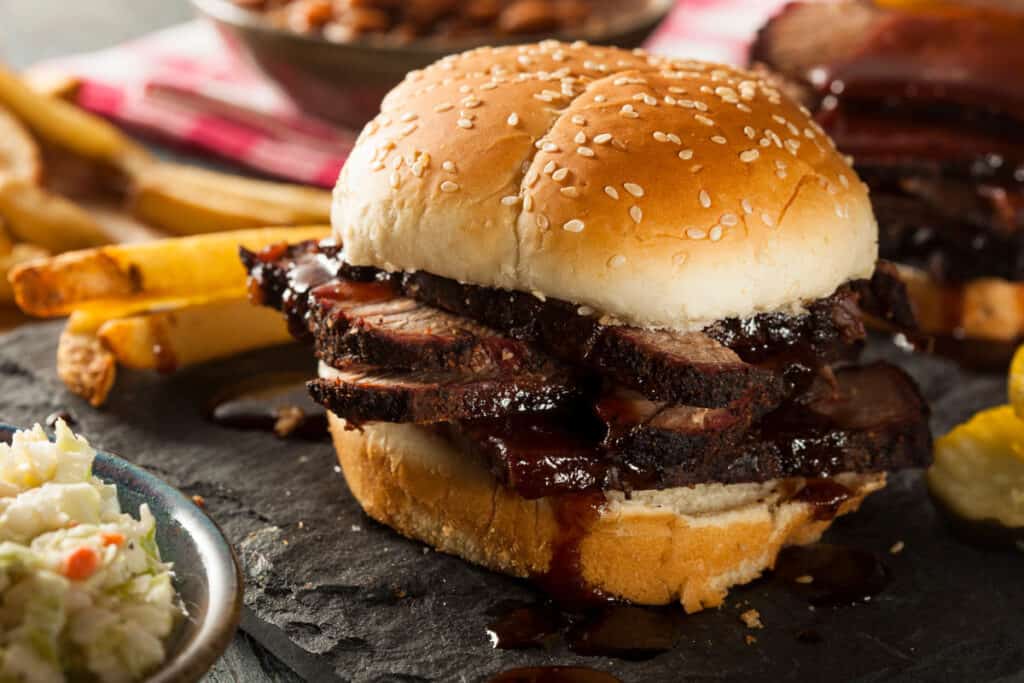
Here are our favorite recipes for each cut that both enhance and compliment the rich beefy flavor.
BBQ Bible's Bacon-Smoked brisket flat
If you've ever cooked a Brisket that turned out dry, this is the recipe for you. By placing the brisket in a foil pan and draping the top with bacon, you protect it from drying out from the heat. All the while, the bacon adds the missing fat to the lean Flat to baste it while it cooks. For a little extra kick, try sprinkling some red chili flakes all over it.
The bacon fat gives the brisket an extra meat depth that only bacon can, because everything is better with bacon! Plus, the spicy edge gives the beef an after-kick that will satisfy those that like it hot. Check it out here: Bacon smoked brisket flat recipe.
Hey Grill Hey's, No-Fail Smoked Texas Brisket
In this guide and recipe, we are taken through the traditional approach to the Texas-style Brisket. From choosing the brisket to seasoning the brisket, as well as how to set up your grill.
The reasoning and steps to wrap and baste your brisket are laid out, and a step-by-step guide for temperature monitoring too. The secret to this recipe is the detail and simplicity. It uses nothing more than a salt and pepper rub to show just how great a simple well-cooked brisket flat can be. Simplicity in action is here in all its glory: Smoked Texas brisket recipe.
Two Best Recipes for Brisket Point Around the Web
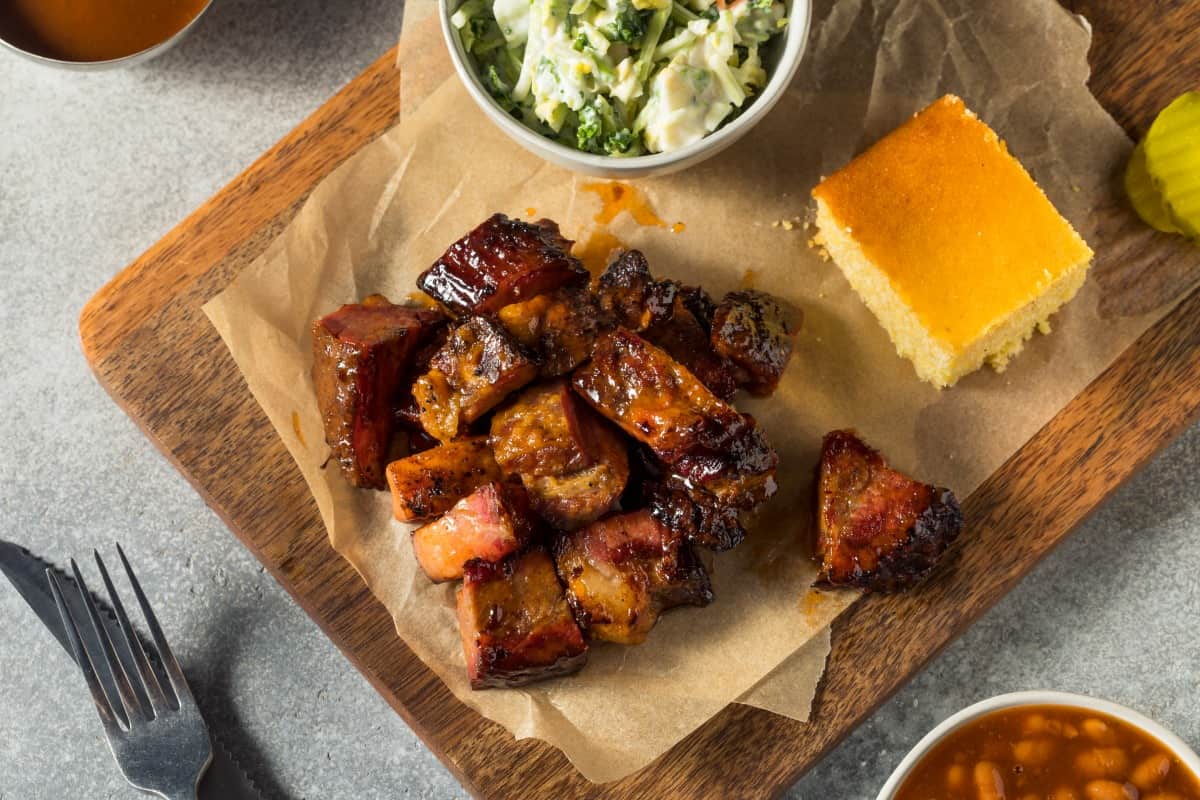
Grillocracy's Better-than-Sex Brisket
This recipe shows you how to approach the brisket with a full cook and wrap method. The wrap is usually a way of preventing the brisket stall and is nicknamed the Texas crutch. But in this recipe, it is used to add an extra flavorful baste and glaze to give it additional depth.
With a mixture including sugar and apple juice, it is certain to give this brisket a sweet and sour edge that will really tickle your taste buds. Especially with the extra sweet barbecue sauce that is poured all over to finish it off. The first step, though, is a decent dry rub that includes sugar and paprika. Get all the details and instructions here: Better than sex brisket recipe.
At BBQs Kansas City Burnt Ends
If you know about burnt ends, you just know. If you don't, then please get to know! They are life-changing, and to think at one point the burnt ends of brisket were given away in restaurants way back when.
This recipe shows you how simple it is to cook your brisket to perfection. And then cut it into cubes that then get smoked again with BBQ sauce to create the burnt ends. The double smoked flavor set BBQ sauce and the tenderness of these bite-sized chunks is something you'll dream about, believe us. Get the recipe now and do yourself a favor: Kansas City burnt ends recipe.
Final Thoughts
The brisket, whether you choose the flat or the point, really is a cornerstone of great barbecues. Once you have mastered the art of cooking it, you will always have a go-to showstopper that friends and family will rave about.
So, whether you want the ultimate flavor fanfare or are looking for a fabulous, lean family feast, you have both in these incredible cuts of beef.
Which cut do you favor, if any? Do you go for the whole Packer? And how do you cook yours to perfection?
Hit us up in the comments and let the battle for best brisket begin.
Source: https://www.foodfirefriends.com/brisket-flat-vs-point/

0 Response to "Is the Beef Brisket Point or Flat Better"
Post a Comment